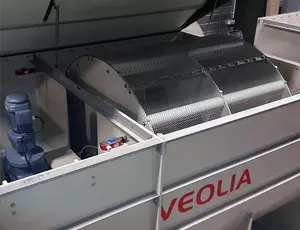A Small-Town Solution: Large Biological Treatment Surface, Compact Footprint
Passive aeration and fixed-film media help make the Ecosim biological treatment systems attractive for on-site decentralized applications and small communities.
Small communities need simple, cost-effective wastewater treatment processes. The ideal system delivers reliably compliant effluent in a package that requires minimal on-site operation and maintenance while having low energy consumption.
For these applications, Veolia Water Technologies offers the Ecosim treatment unit. It was developed by way of an alliance between two of the company’s subsidiaries: AnoxKaldnes and PMT. The unit consists of a rotating drum containing a volume of moving-bed bioreactor media.
This configuration provides a large biological treatment surface area, enabling substantial capacity in a compact footprint. In operation, the unit is essentially silent and odorless. It can be integrated with a variety of upstream and downstream processes to meet users’ specific treatment requirements.
The system treats wastewater effectively without blowers or other mechanical aeration devices. Ashley Waples, product manager for Veolia’s PMT and Ditch Technologies, talked about the unit and its capabilities in an interview with Treatment Plant Operator.
TPO: What is the basic market for this system?
Waples: It is intended for smaller decentralized onsite treatment, as well for small municipalities, or areas in larger communities where treatment is needed, but tie-in to the centralized system is not available.
TPO: Why is this technology a good fit for such applications?
Waples: It is a good fit because it has very low energy consumption and a small footprint. There is no aeration from a blower. It is passive aeration achieved by the turning of a drum, which alternately exposes fixed-film media to the influent and to oxygen through immersion and emersion. The process uses just a single motor.
TPO: What is the capacity range or the unit?
Waples: A single unit can treat a flow as low as 5,000 gpd, or as high as 50,000 gpd.
TPO: How does this process differ from other integrated fixed-film systems?
Waples: It combines the benefits of a rotating biological contactor with our AnoxKaldnes media, which provides the benefit of additional treatment surface area.
TPO: How are immersion and emersion accomplished?
Waples: The process water covers about 40% of the drum. Inside the drum are compartments that contain the media. There is fixed-film bacterial growth on the AnoxKaldnes media. The drum rotates at 2 to 2.5 rpm. When the media is in the process water, it’s exposed to nutrients. When exposed to the air, it has access to oxygen without any form of blower.
TPO: What equipment is needed upstream of this system?
Waples: There are a variety of options from clarifiers to some type of settling process or flow equalization. We recommend screening at about 6 mm. From there it depends on the influent characteristics and whether the flow is fairly constant or variable.
TPO: How are solids handled in this process?
Waples: We can design Ecosim systems in a variety of ways. The biological process can discharge directly to some kind of effluent collection and disinfection process, and then sludge just comes out of the process water. We also offer an integral lamella settler system or an integral drum filter to separate the solids from the effluent. The sludge then can go to drying beds or to a settler digester.
TPO: What effluent quality can Ecosim units produce?
Waples: For the biological process alone, we achieve a range of 70-90% BOD removal, along with nitrification to 1 to 5 mg/L ammonia in the effluent. With the addition of a drum filter we can achieve 10-20 mg/L effluent TSS, and with the lamella settler 20-30 mg/L TSS. BOD will be in the range of 10-30 mg/L depending on the downstream processes. With the Ecosim unit alone, BOD might be 30 mg/L or higher. We design biological process with the hydraulic retention time dependent on the user’s needs. We can easily design it to achieve BOD lower than 30 mg/L with the addition of a drum filter or lamella settler.
TPO: Where would this system discharge effluent?
Waples: The effluent would generally be discharged to a drainfield or a stream, depending on what the regulations are and where the system is located.
TPO: Where would this system discharge sludge:
Waples: The sludge could simply be collected and trucked out, or it could be discharged to a reed bed, a drainfield or sludge holding, depending on the owner preference.
TPO: What accounts for the low operation and maintenance cost of this technology?
Waples: A key advantage is the single motor for the entire system. Even with the addition of an integral drum filter, it’s a single small motor that rotates the drum, and small pump that intermittently cleans the drum filter using effluent from the system as backwash water. There is very low operation and maintenance cost compared to an aerated system with blowers or other supplemental air.
TPO: How much operator attention is required?
Waples: There is no need for a full-time operator. Only a weekly maintenance check is required.
TPO: How does the product design incorporate durability?
Waples: The tank construction material is polypropylene reinforced with stainless steel. It is lightweight and highly chemical resistant. The drum and shaft are stainless steel.
TPO: How are units installed?
Waples: Systems come lidded and can be buried or mounted on a pad or on gravel. For indoor installations, system can be installed without a lid and so be a little more cost-effective.



